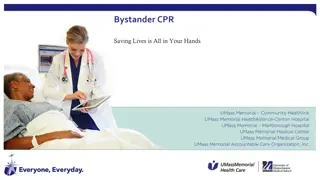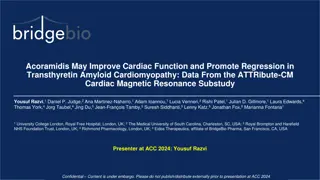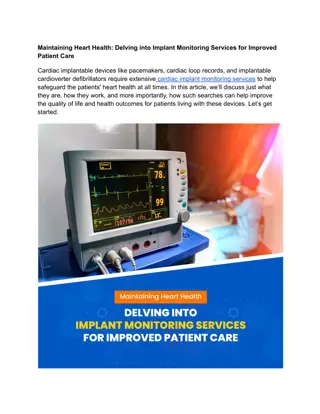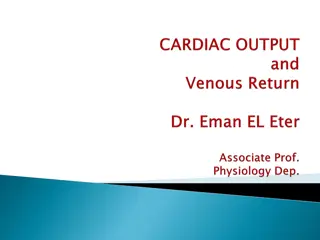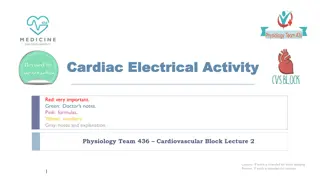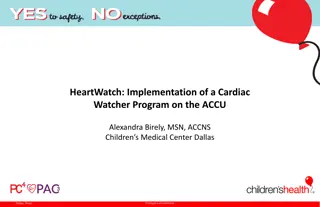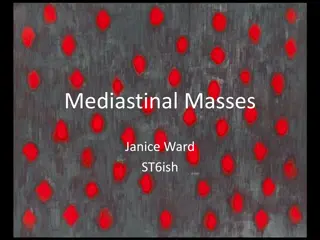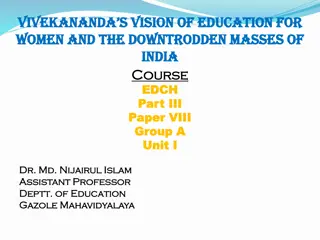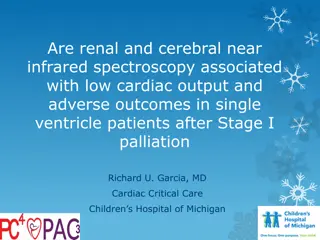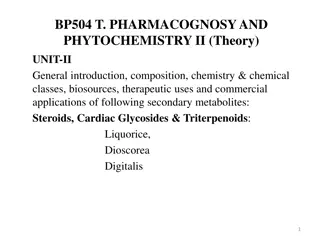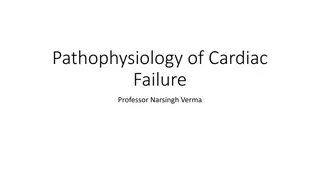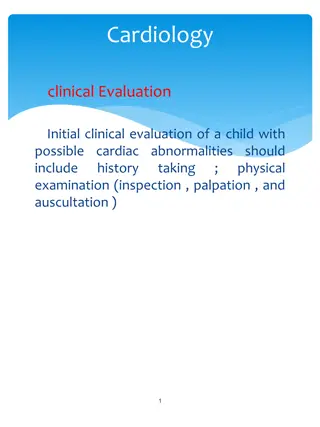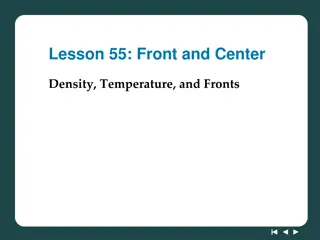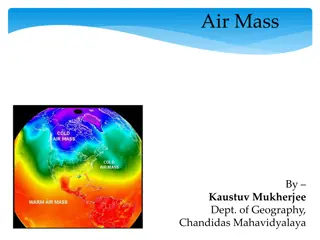
Cardiac Masses: Introduction, Classification, and Presentation
Explore the world of cardiac masses, their types, prevalence, and clinical presentations. Learn about primary and secondary tumors, their characteristics, and diagnostic approaches.
Download Presentation

Please find below an Image/Link to download the presentation.
The content on the website is provided AS IS for your information and personal use only. It may not be sold, licensed, or shared on other websites without obtaining consent from the author. If you encounter any issues during the download, it is possible that the publisher has removed the file from their server.
You are allowed to download the files provided on this website for personal or commercial use, subject to the condition that they are used lawfully. All files are the property of their respective owners.
The content on the website is provided AS IS for your information and personal use only. It may not be sold, licensed, or shared on other websites without obtaining consent from the author.
E N D
Presentation Transcript
By Dr. Khaled M. Abdel Aal MD Cardiothoracic surgery Associate Prof. & Consultant of Cardiothoracic surgery Sohag University
Cardiac Masses Items to be covered: Introduction Classification Presentation Evaluation Common types Summary
Introduction Improvement of cardiac Imaging and Surgery have changed cardiac tumors from a postmortem curiosity to a ready diagnosed and frequently treatable form of heart disease. Cardiac tumors can be located in the Epicardium, Myocardium, and Endocardium. Either primary or secondary. Secondary tumors are commonest.
Introduction Prevalance: Primary tumors <3/10,000 autopsies Over are benign Secondary 20-40 x more common Present in upto 20% of patients dying of malignancy
Classification I. Primary cardiac tumors: Benign Malignant II. Seconderycardiac tumors: Benign malignant
Primary cardiac tumors Benign: Myxoma Papillary fibroelastoma Fibroma Lipoma Rhabdomyomas Malignant: Angiosarcomas Rhabdomyosarcomas Mesotheliomas Lymphoma Intrapericardial Pheochromocytomas
Secondary Cardiac Tumors Malignant: Carcinoma (common) Melanoma carcinoid Benign: IntracardiacThrombus Leiomyomatosis Endomyocardial fibrosis
Presentation Embolization Systemic Pulmonary (less common) Obstruction Arrhythmia Tamponade Direct compression of coronary artery Intramyocardial Conduction disturbances Global dysfunction due to infiltration
Normal Variants on Echo Many benign findings on echo often misinterpreted as pathologic: Eustatian valve 2. Catheters 3. crista terminalis 5. coronary sinus 6. moderator band 7. muscle bundles 8. False chords 9. Trabeculations 1. 4. Suture line 10.Brachiocephalic vein
Benign Primary Cardiac Tumors Myxomas The most common primary cardiac tumor in the Age > 35 Arise from the endocardium 75% in the Lt. Atrium near fossa ovalis 15% Rt. Atrium 5-10% Lt. Ventricle 5% multiple sites
Myxomas Grossly Typically pedunculated Gelatinous consistency Friable Histologically Copious mucopolysaccharide stroma Scattered solitary or clustered polygonal cells.
Myxoma 90% are solitary, average size 5-6cm (range 1-15 cm) Average age of presentation is 50 years old Presentation: Embolisation 2. Heart failure (obstruction, arrhythmia) 3. Constitutional manifestations 1.
Myxoma Constitutional Extra cardiac manifestations suggestive of Collagen Vascular disease Fever ESR elevation Anemia Thrombocythemia Circulating autoantibodies
Myxoma Usually occur sporadically but at least 7 % occur as a part of an autosomal dominant syndrome called Carney Complex spotty pigmentation of the skin Peripheral myxoid tumors (cutaneous myxoma, myxoid mamary fibroadenoma) Endocrine over activity (Cushing s syndrome, pituitary adenomas, testicular Sertoli cell tumors)
Management Myxoma High propensity for embolization Surgical results excellent Treatment is surgical with en bloc resection including rim of septum around base
Management Myxoma Recurrence in about 1-5% of cases (incomplete resection, implantation from first tumor etc) - therefore annual surveillance recommended In the familial Carney complex risk of recurrence 12-22%
Papillary Fibroelastomas Benign papilloma of endocardium Average age of detection is 60 years old Found equally in men and women Many are clinically silent but can result in emboli
Papillary Fibroelastoma Echo Features 90% are single, with median diameter of 8mm Most commonly found on downstream side of valves (can be confused for vegetations) Less common locations: Papillary muscle, chordae tendenaeor atria Mobility is common and risk factor for embolization Valvular regurgitation is rare
Papillary Fibroelastoma Treatment Most recommend resection, especially for left sided lesions Risk of embolism can be up to 25% over 3 years and 6% in asymptomatic patients in whom the fibroelastoma was found incidentally Surgery can usually be valve-sparing Recurrences have not been reported
Cardiac Lipomas Uncommon benign tumor, usually small and found on epicardial surface True lipomas are rare, more often present as lipomatous hypertrophy of the interatrial septum Highly echogenic Usually present in inferior and superior portions of the septum with sparing of fossa ovalis dumbell-shaped
Cardiac Lipomas Associated with atrial arrhythmias No enhacement on MRI, decreased signal with fat suppression True lipomas Lipomatous hypertrophy if SVC obstructed or significant arrhythmias resection surgery only
Rhabdomyomas and Fibromas Most common cardiac tumor in children Rhabdomyomasoccur within a cavity or embedded within myocardium, usual small and multiple; often regress on own Fibromas are well-demarcated, echogenic masses that can extend into cavity and result in obstruction and arrhythmia; often found in free wall of LV On MRI rhabomyomasare hyperintenseon T2, while fibromas are hypointenseon T2 and iso-intense after gadolinium
Malignant Primary Cardiac Tumors Angiosarcoma Most common primary malignancy of the heart Malignant cells that form vascular channels Most commonly affect the Rt. Heart Rt. Atrium Pericardium Hemorrhagic effusion Thrombus
Malignant Primary Cardiac Tumors Angiosarcomas: Diffuse, irregularly shaped Mean survival one year Successful Rx with Chemo and XRT followed by transplant reported
Malignant Primary Cardiac Tumors Rhabdomyosarcomas Most commonly seen in adults No chamber selectivity No pericardial involvement Multiple sites of cardiac involvement is common Poor prognosis Limited success with resection and adjuvant Rx.
MalignantSecondary Cardiac Tumors Metastases can manifest in the heart as a mass, pericardial disease, myocardial involvement Tumors can spread to heart by: direct invasion, spread through venous system or hematongenously Cardiac involvement is often established at autopsy in patients with otherwise widely metastatic disease
Metastatic Disease to the Heart Primary Malignancy Cardiac Effect Lung Direct extension, effusion Breast Hematogenous/lymphatic spread, effusion Lymphoma Lymphatic spread, variable effects GI Variable Melanoma Intracardiac and myocardial Involvement Renal Cell Carcinoma IVC-RA-RV extension, can look like thrombus Carcinoid Tricuspid and pulmonic valve abnormalities
Intracardiac Thrombus Intracardiac source of emboli account for approximately 15-20% of strokes TEE is imaging modality of choice for evaluation of intracardiac thrombus and source of emboli (except for LV apex) Major sources: LA (45%), LV apex, aorta, valve prosthesis, abnormal interatrial septum (aneurysm)
Imaging Intracardiac Thrombus Transthoracic Echo with/without contrast best for LV thrombi associated with aneurysm or akinesis of the apex TEE best for all other locations of thrombus MRI excellent way to identify thrombus; usually identified on spin echo and gadolinium enhanced images with delayed enhancement
LV Thrombus Echo Features Sensitivity of TTE to detect LV thrombus is 75- 95% Associated with myocardial infarction that results in akinesis of the apex or dilated cardiomyopathy resulting in slow flow May be multiple, mobile Texture usually distinct from myocardium Risk factors for embolism: large size, mobility, and protrusion into LV cavity TTE used to follow LV thrombi over time
LA Thrombus Echo Features LA appendage is most likely site Associated conditions: Atrial Fibrillation, mitral stenosis, LV failure The LAA can be multi-lobed in up to 70% of patients Sensitivity of TEE to detect an LA thrombus approaches 95%, with equally high specificity TEE evaluates size, mobility, emptying velocity, extension into LA, and interatrial aneurysm if present Can also assess spontaneous echo contrast
Summary Primary Cardiac tumors are rare and usually benign Clinical presentation based on location and size of mass Echo (TTE and TEE) remains the initial imaging test CMR is a useful modality to further characterize intracardiac masses (especially lipomas, angiosarcomas and thrombi) and narrow the differential diagnosis Treatment usually involves surgery for tumors

